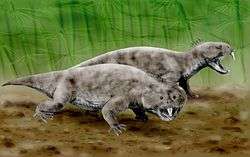Hyperodapedontinae
| Hyperodapedontinae Temporal range: Carnian - Early Norian (Possible Middle Triassic origin) | |
|---|---|
 | |
| life restoration of Hyperodapedon | |
| Scientific classification | |
| Kingdom: | Animalia |
| Phylum: | Chordata |
| Class: | Reptilia |
| Order: | †Rhynchosauria |
| Family: | †Rhynchosauridae |
| Clade: | †Hyperodapedontidae |
| Subfamily: | †Hyperodapedontinae Chatterjee, 1969 |
| Subgroups | |
Hyperodapedontinae is a subfamily of rhynchosaurs within the family Hyperodapedontidae. Fossils have been found from Argentina, Brasil, Canada, India, Madagascar, Scotland, Tanzania, United States and Zimbabwe.[1][2]
Phylogeny
Hyperodapedontinae was erected by Sankar Chatterjee in 1969 as a coordinate name of the family Hyperodapedontidae Lydekker, 1985. Chatterjee (1969) originally named Hyperodapedontinae to include all Late Triassic rhynchosaurs known at that time, H. gordoni, H. huxleyi and "Scaphonyx" fischeri, and proposed a morphological diagnosis for the clade.[3][4] Scaphonyx includes two additional species, S. africanus and S. australis, all of which are currently believed to be dubious. As noted by Langer et al. (2000), using Chatterjee' morphological definition would exclude Teyumbaita and H. huenei from the clade, and thus it would be nested within Hyperodapedon. To preserve the name, with its original stratigraphical meaning, Langer et al. (2000) redefined Hyperodapedontinae as a stem-based taxon that includes "all rhynchosaurs closer to Hyperodapedon than to "Rhynchosaurus" spenceri (now Fodonyx)".[4][5]
The cladogram below follows Mukherjee & Ray (2014):[6]
| Hyperodapedontinae |
| |||||||||||||||||||||||||||||||||||||||||||||||||||||||||||||||
| |
Valid species that were first assigned to Scaphonyx.
References
- ↑ Felipe Chinaglia Montefeltro (2008). "Inter-relações filogenéticas dos rincossauros (Diapsida, Archosauromorpha)". Unpublished Thesis, Biology Department, Universidade de Saõ Paulo, Ribeiraõ Preto: 203 pp.
- ↑ David W. E. Hone; Michael J. Benton (2008). "A new genus of Rhynchosaur from the Middle Triassic of South-West England". Palaeontology. 51 (1): 95–115. doi:10.1111/j.1475-4983.2007.00739.x.
- ↑ Chatterjee, Sankar (1969). "Rhyncosaurs in time and Space". Proceedings of the Geological Society of London. 1658: 203–208.
- 1 2 Max C. Langer; Cesar L. Schultz (2000). "A new species of the Late Triassic rhynchosaur Hyperodapedon from the Santa Maria Formation of south Brazil". Palaeontology. 43 (6): 633–652. doi:10.1111/1475-4983.00143.
- ↑ Max C. Langer; Felipe C. Montefeltro; David E. Hone; Robin Whatley; Cesar L. Schultz (2010). "On Fodonyx spenceri and a new rhynchosaur from the Middle Triassic of Devon". Journal of Vertebrate Paleontology. 30 (6): 1884–1888. doi:10.1080/02724634.2010.521901.
- ↑ Mukherjee, D., Ray, S. (2014), A new Hyperodapedon (Archosauromorpha, Rhynchosauria) from the Upper Triassic of India: implications for rhynchosaur phylogeny. Palaeontology. doi: 10.1111/pala.12113


